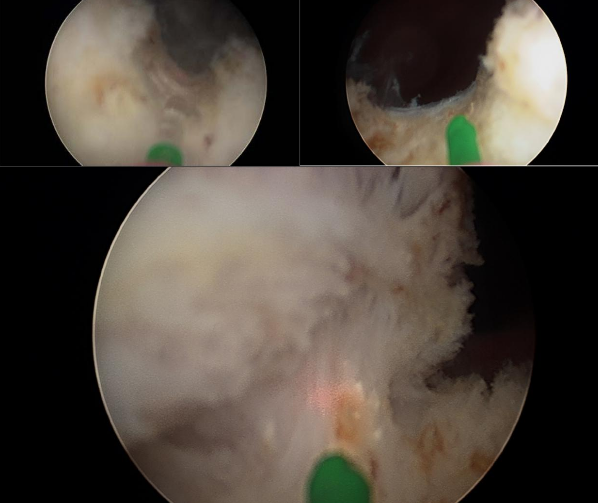Holmium Laser Enucleation of the Prostate (HoLEP)
BPH is a benign condition in which the prostate grows and causes urinary outlet obstruction. This can lead to significant urinary symptoms including urinary frequency, urinary urgency, feelings of incomplete emptying, having to get up to urinate at night, a hard time starting a urinary stream, or a weak stream that starts and stops.
Medications can often be effective in the treatment of these symptoms and are usually the first line medical treatment. There are a couple of medications that are available for these treatments. These include alpha blockers: Hytrin, Cardura, Uroxatrol, Flomax, and Rapaflo. They work by relaxing the prostate to allow the urine to flow better. The most common side effects include: dizziness, light headedness, nasal congestion and reduced ejaculate. Other medications can slowly shrink the prostate. This class includes Proscar and Avodart. The most common side effects of these medications can cause sexual side effects.
There are some relative indications for BPH treatment which include: urinary retention, large postvoid residual (the amount of urine left behind in the bladder after voiding) which can interfere with kidney function, recurrent episodes of bleeding due to an enlarged prostate, recurrent urinary tract infection, and bothersome voiding symptoms that are not effectively controlled with medications or the medications cause significant side effects. Bladder stones can also be a sign that your bladder urine is not completely emptying. There are different surgical interventions that are available.
What types of procedures are available?
A recent review lists over a dozen types of procedures available to treat BPH. Current interventions for the enlarged prostate include transurethral microwave thermotherapy (TUMT), transurethral needle ablation (TUNA), radiofrequency generated thermal therapy, in the form of water vapor, directly to the extra prostate tissue (Rezūm), different types of laser procedures for the prostate including photovaporization, removal of glandular tissue intact (laser enucleation – HoLEP) and transurethral resection of the prostate (TURP), including button TURP. In recent years, laser techniques including photo selective vaporization of the prostate (green light laser PVP) and Holmium laser enucleation of the prostate have emerged as an effective and minimally invasive procedure available for managing BPH.
Holmium laser enucleation of the prostate (HoLEP)
HoLEP is a minimally invasive treatment for an enlarge prostate. No incisions are used while doing this procedure. HoLEP uses a laser to remove prostate that is blocking the flow of urine. A camera is used to perform a cystoscopy which evaluates the bladder and urethra. The camera is then directed through the urethra to access the enlarged obstructing prostate in the urethra near the bladder. Laser energy is then used to cut out the prostate gland. The holmium laser can vaporize and cut through the prostate, but also helps to cauterize / coagulate small to medium-sized blood vessels. By following the anatomic planes, a significant amount of prostate can be resected with minimal amounts of bleeding. During HoLEP, the prostate is resected into larger sections. These sections are then placed into the bladder. Another device called a morcellator is then used to digest these larger pieces. This prostate specimen is sent to the pathologist to evaluate for cancer or other abnormal findings. HoLEP has been well studied and is ideal for larger prostates as well. It can remove the tissue on a prostate that would previously require a surgery requiring a large incision on your stomach that would often require a couple day stay in the hospital.
What to expect after a HoLEP?
Patient’s often can often go home several hours after the procedure, but sometimes need to spend one night in the hospital. There is a catheter in that typically stays in overnight, and sometimes needs to stay in for couple of days. Patient’s may see blood in their urine on an intermittent basis for several weeks. Strenuous exercise, heavy lifting, and sexual activity should be avoided for at least 2 weeks after surgery to prevent exacerbating this bleeding. This procedure should not affect your ability to get an erection and have an orgasm, but can create a “dry climax” where no ejaculate comes out. This retrograde ejaculation is a common finding. Some men may have some burning with urination after the procedure and increased urinary frequency and urgency as well. These symptoms and typically mild and resolve after a couple of weeks. There are sometimes you can have some leakage of urine after the catheter comes out as well. This typically resolves itself in 6 weeks. Very rarely can these symptoms continue on a long term basis.
In previous studies, HoLEP was an endoscopic procedure that has shown superiority to TURP for peak flow and symptom improvement. There is a lower bleeding risk as compared to TURP as well. The need for repeat procedures after having a HoLEP is low with less than 2 percent of men needing a subsequent re-treatment for urinary symptoms.

The laser fiber has a green coating. Here the laser is seen cutting down to the prostatic capsule. The laser is then used to scrape the tissue into the bladder where it can be chewed into smaller pieces for removal with a device called a morcellator.
Print PageContact us to request an appointment or ask a question. We're here for you.



